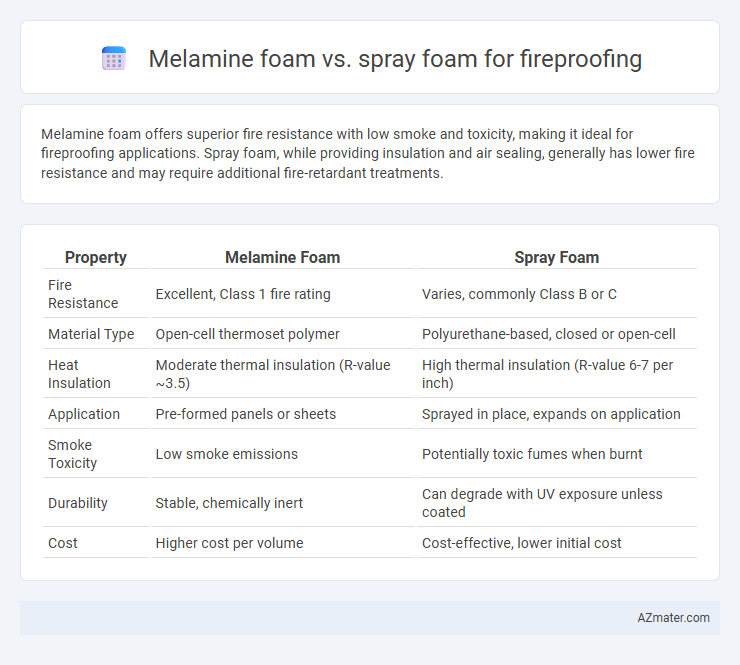Melamine foam offers superior fire resistance with low smoke and toxicity, making it ideal for fireproofing applications. Spray foam, while providing insulation and air sealing, generally has lower fire resistance and may require additional fire-retardant treatments.
Table of Comparison
| Property | Melamine Foam | Spray Foam |
|---|---|---|
| Fire Resistance | Excellent, Class 1 fire rating | Varies, commonly Class B or C |
| Material Type | Open-cell thermoset polymer | Polyurethane-based, closed or open-cell |
| Heat Insulation | Moderate thermal insulation (R-value ~3.5) | High thermal insulation (R-value 6-7 per inch) |
| Application | Pre-formed panels or sheets | Sprayed in place, expands on application |
| Smoke Toxicity | Low smoke emissions | Potentially toxic fumes when burnt |
| Durability | Stable, chemically inert | Can degrade with UV exposure unless coated |
| Cost | Higher cost per volume | Cost-effective, lower initial cost |
Introduction to Fireproofing Materials
Melamine foam and spray foam are prominent fireproofing materials used in construction and industrial applications. Melamine foam offers excellent flame retardant properties and exceptional thermal insulation due to its open-cell structure, making it suitable for passive fire protection. Spray foam, typically polyurethane-based, provides rapid expansion and strong adhesion but varies in fire resistance depending on its chemical formulation and the presence of fire retardants.
What is Melamine Foam?
Melamine foam is a lightweight, open-cell material known for its excellent fire resistance and sound absorption properties, making it ideal for fireproofing applications. Unlike spray foam, which is a polyurethane-based insulator that expands and hardens after application, melamine foam remains flexible and does not emit toxic fumes when exposed to high temperatures. Its thermal stability and flame-retardant characteristics make melamine foam a preferred choice in fireproofing systems for buildings and industrial equipment.
What is Spray Foam?
Spray foam is an insulating material composed of polyurethane, applied as a liquid that rapidly expands and hardens to form a dense, airtight barrier. It enhances fireproofing by creating a seamless seal that reduces air leakage and inhibits the spread of flames and smoke. Unlike melamine foam, spray foam provides superior structural insulation along with fire-resistance, making it ideal for comprehensive thermal and fire protection in buildings.
Fire Resistance Properties Comparison
Melamine foam offers excellent fire resistance due to its inherent non-combustible structure and ability to char without producing toxic smoke, making it highly suitable for passive fire protection. Spray foam, while effective for insulation, generally contains combustible components and requires fire-retardant additives to meet fire resistance standards and reduce flame spread. Comparatively, melamine foam provides superior fire resistance performance, especially in applications demanding stringent fire safety compliance and minimal smoke generation.
Thermal Insulation Performance
Melamine foam offers superior thermal insulation performance due to its open-cell structure and low thermal conductivity, making it highly effective for passive fireproofing applications. Spray foam, particularly closed-cell varieties, provides strong insulation with R-values typically ranging from 6 to 7 per inch, but it can lose effectiveness if exposed to high temperatures during a fire. Melamine foam's inherent fire-retardant properties and ability to maintain thermal stability at elevated temperatures make it a preferred choice for applications requiring both insulation and fire resistance.
Installation Process and Ease of Application
Melamine foam offers a straightforward installation process due to its lightweight, rigid structure that can be cut and fitted into cavities or applied as panels without specialized equipment. Spray foam requires professional handling and special tools for proper mixing and spraying, making the application more complex and time-consuming. Melamine foam's ease of shaping and placing makes it ideal for quick, precise fireproofing, whereas spray foam provides thorough coverage but demands expert installation for optimal fire resistance.
Durability and Longevity
Melamine foam offers superior durability and long-term fire resistance due to its open-cell structure and inherent thermal stability, maintaining performance in high-temperature environments without significant degradation. Spray foam, while providing effective initial fireproofing, may suffer from reduced longevity as it can degrade or shrink over time when exposed to continuous heat and moisture. Therefore, melamine foam is often preferred in applications requiring consistent fireproofing durability and extended service life.
Environmental Impact and Safety
Melamine foam offers superior fire resistance due to its inherent intumescent properties, decomposing at high temperatures to form a protective char while releasing minimal toxic gases, making it safer for indoor environments. Spray foam, often composed of polyurethane, can emit volatile organic compounds (VOCs) during application and combustion, posing potential health risks and contributing to indoor air pollution. Melamine foam's environmentally friendly profile, including recyclability and lower chemical emissions, contrasts with spray foam's reliance on petrochemical derivatives and challenges in disposal.
Cost Analysis: Melamine Foam vs Spray Foam
Melamine foam typically costs more upfront per square foot compared to spray foam but offers superior fire-resistant properties and low smoke generation, making it a valuable investment for high-safety applications. Spray foam presents a lower initial price and provides good insulation, but may require additional fire retardant treatments to meet stringent fireproofing standards, increasing total costs over time. Evaluating long-term safety benefits alongside installation and maintenance expenses is crucial for an accurate cost analysis between melamine foam and spray foam in fireproofing projects.
Choosing the Best Foam for Fireproofing Needs
Melamine foam offers superior fire resistance with inherent flame-retardant properties and low smoke emissions, making it ideal for fireproofing applications where safety and compliance are critical. Spray foam, while excellent for insulation and air sealing, typically requires fire retardant additives or coatings to meet stringent fireproofing standards. Selecting the best foam depends on the specific fire rating requirements, application environment, and long-term durability needs, with melamine foam favored for high-performance fireproofing and spray foam for combined insulation and moderate fire resistance.

Infographic: Melamine foam vs Spray foam for Fireproofing
 azmater.com
azmater.com